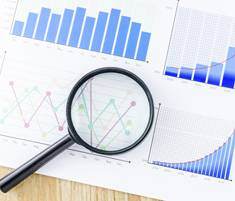Sales forecasts drive production and investments, so accuracy is critical.

If you’re overly optimistic, you have inventory sitting in your warehouses. If your forecast is too low, the shelves are empty and you lose revenue. The forecasting process is often driven by push – increasing revenue goals to motivate the sales department.
At the same time, other departments are seeking to constrain costs by tightening inventory levels and purchasing. In addition, just-in-time inventory management systems need to buffer against market swings, especially when materials are in short supply.
These conflicting internal goals, along with today’s short product life cycles and expectations of decreased delivery time, are nudging companies toward demand-driven forecasting. Selling the right products to the right customers at the right time is essential to increase revenues.
In late 2014, Industry Week surveyed manufacturing executives to find out where they stood regarding demand-driven forecasting. They found that 49 percent of companies had minimal adoption of demand-driven methods, especially those with under $100 million in sales. In contrast, about 70 percent of the larger companies report widespread adoption of the practice.
Most managers, however, appear to understand the benefits of better forecasting. About two-thirds predicted possible sales increases from 3 percent to more than 11 percent.
A majority also reported they could reduce costs by the same amount, thereby increasing profitability. Specific improvements cited included improved productivity, reduction in backorders and out-of-stocks, and better customer service.
Companies adopting demand-drive forecasting use it for a variety of purposes in addition to sales forecasting. These include ongoing operational planning as well as capital investments and innovation timing. Unfortunately, fewer than half using this forecasting method report high accuracy – defined as 80 percent or better compared to actual sales. In light of this disparity between potential benefits and actual performance of current forecasting methods, the study made suggestions for best practices. These revolved around data quality and tools.
Data quality is the linchpin of accurate forecasting. The problem is often not the amount of data available, but deciding which information is the most useful.
Data management is also complicated by the rise in stock-keeping units (SKUs) offered by companies, which means more products to forecast and track. Many demand-driven systems use customer orders and shipments, which is a step in the right direction. However, reliability is affected by what happens at the transaction level.
As in other planning activities, moving closer to the source provides increasingly accurate input. In the case of demand-driven forecasting, point of sale data (POS) and tag scanning (RFID) are the highest quality sources since they verify actual purchases. The effectiveness of promotional activities can be measured against sales using these technologies. The impact of price changes or advertising can be seen immediately.
According to the survey, only one in three respondents is presently using POS data. Another area for improvement is using data collected effectively enough. Predictive analytics and data mining are used extensively by only 7 percent of companies.
Surprisingly, with the sophistication of today’s software, more than 80 percent of companies use spreadsheet programs to analyze data and prepare forecasts. Other methods are only gradually being adopted, such as moving average and time-series models.
This analysis attempts to discover patterns in customer behavior that can be extrapolated into demand predictions. As with any model, the results need to be adjusted using other intelligence. External events, competitor activity and even the weather can influence purchasing behavior.
Integrating demand forecasting throughout company function areas is essential for accuracy and to build consensus about sales initiatives. Input from managers along the production chain is critical in testing the validity of forecasts.
Once developed, forecasts need to be reviewed and adjusted as new information becomes available from function areas and sales data.
In addition to increasing sales overall as production is better targeted, demand-driven forecasting can contribute to what is called demand shaping. Long the province of retailers, applying push psychology to boost sales will minimize dead inventory.
Prices can be tinkered with, promotional activities and merchandizing can be adjusted, and advertising content can be honed. Obtaining and analyzing customer activity is the key.



